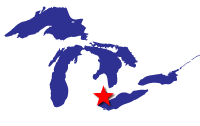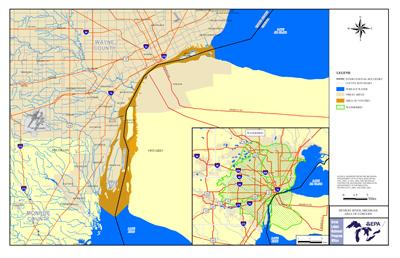Detroit River AOC
Locate It
Contact Us
Rose Ellison
ellison.roseanne@epa.gov
734-692-7689
On this page:
Latest News
- Detroit Riverwalk Great Lakes Legacy Act Project in the Detroit River AOC
- EPA announces $2.5 million plan to advance cleanup of Detroit River Area of Concern
Overview
The Detroit River was designated as an Area of Concern under the Great Lakes Water Quality Agreement of 1987.
The Detroit River is part of the international boundary between the United States and Canada. The Detroit River is a 32-mile long channel linking Lake St. Clair and the upper Great Lakes to Lake Erie. Physical boundaries of the AOC extend from the flashing navigation light near Peche Island to the Detroit light in Lake Erie.
The Detroit River Area of Concern (AOC) is one of five binational AOCs. It drains an area of land in Michigan and Ontario that is approximately 700 square miles. The Detroit River itself runs a total of 32 miles as it progresses from Lake St. Clair to Lake Erie.
It can be misleading to think of the Detroit River as a typical river with a fan-shaped watershed. Instead, it is part of a strait that connects the Upper Great Lakes to the Lower Great Lakes. Lake Huron water comprises 95 percent of the flow of the Detroit River via the St. Clair River and Lake St. Clair (MDNR 1991).
There are five Michigan tributaries to the Detroit River, one of which, is the Rouge River AOC. Three additional tributaries drain from the Ontario portion of the watershed. Lake St. Clair and two additional AOCs, the Clinton River AOC and the St. Clair River AOC, are immediately upstream of the Detroit River.
Historically, the Detroit River has been a source of water for a variety of industry and has experienced rapid residential development within its watershed. For decades, the river received untreated waste discharges from industrial use, as well as inputs from urban development and stormwater runoff, degrading the river. These pollution sources have contributed to high levels of bacteria, PCBs, polycyclic aromatic hydrocarbons (PAHs), metals, oils, and greases within the AOC.
The Detroit River AOC has the largest city (Detroit) in the state of Michigan along its shoreline. Eleven out of 14 beneficial use impairments (BUI) have been identified as impaired. Due to efforts from ongoing federal, state, NGOs, and the local Public Advisory Council, two of those BUIs, Tainting of Fish and Wildlife Flavor and Restrictions on Drinking Water Consumption, or Taste and Odor have been removed. Priorities addressing combined sewer and sanitary sewer overflows, nonpoint source pollution, contaminated sediment, habitat restoration and pollution prevention are leading to continued improvement within the AOC.
Beneficial Use Impairments
An interim success of remediation and restoration work is removing beneficial use impairments. Beneficial use impairments are designations given by the International Joint Commission representing different types of significant environmental degradation. As cleanup work is completed, and monitoring demonstrates sufficient environmental health improvements, BUIs can be removed. The list below shows which BUIs have been removed, and which remain. Once all BUIs are removed, the process of delisting the AOC can begin.
- Tainting of Fish and Wildlife flavor(22 pp, 1.73 MB, About PDF)– REMOVED 2013
- Restrictions on Drinking Water Consumption, or Taste and Odor (8 pp, 598 K) – REMOVED 2011
- Restrictions on Fish and Wildlife Consumption
- Degradation of Fish and Wildlife Populations
- Beach Closings
- Fish Tumors or Other Deformities
- Degradation of Aesthetics
- Bird or Animal Deformities or Reproduction Problems
- Degradation of Benthos
- Restriction on Dredging Activities
- Loss of Fish and Wildlife Habitat
More information:
- General information about BUIs: Beneficial Use Impairments for the Great Lakes AOCs
Remediation and Restoration Work
The Detroit River AOC has many partners working together to address the existing beneficial use impairments. Efforts towards contaminated sediment remediation and habitat restoration have made significant progress, but there is still much work left to do.
There has been one completed Great Lakes Legacy Act (GLLA) sediment contamination cleanup project within the Detroit River AOC, the Black Lagoon Great Lakes Legacy Act Cleanup. Current GLLA projects include Upper Trenton Channel (UTC), the Monguagon Creek – Upper Trenton Channel (MCUTUC), Centennial Park and Uniroyal Shoreline. Results from previous sampling efforts show there are likely several GLLA projects that will be needed in the future. Visit the IL/IN Sea Grant web pages to see more information on Upper Trenton Channel and Black Lagoon.
Highlighted below are a few examples of the many restoration and remediation projects that are necessary to remove the Detroit River AOC’s designated BUIs. For more information on progress within the Detroit River AOC, that include both GLRI and non-GLRI funded projects, please see this story map created by Friends of the Detroit River.
Highlighted Habitat Restoration and Sediment Remediation Work
- Lake Okonoka Habitat Restoration Project.
- Celeron Island Habitat Restoration Project.
- The Black Lagoon Great Lakes Legacy Act Cleanup.
Lake Okonoka Habitat Restoration Project
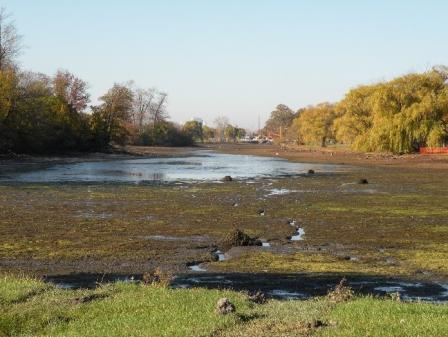 Lake Okonoka was drained in the fall of 2017 to prepare for construction of channels and deep pools. Photo Credit: Friends of the Detroit River.Lake Okonoka is located on Belle Isle, an island in the Detroit River. In the 1950s the lake was disconnected from the Detroit River, preventing Great Lakes fish from utilizing the lake for habitat. In 2014, a partnership between the Friends of the Detroit River, National Oceanic and Atmospheric Administration (NOAA), and Michigan Department of Natural Resources began designing the project to reconnect Lake Okonoka and the Detroit River by installing culverts and channels.
Lake Okonoka was drained in the fall of 2017 to prepare for construction of channels and deep pools. Photo Credit: Friends of the Detroit River.Lake Okonoka is located on Belle Isle, an island in the Detroit River. In the 1950s the lake was disconnected from the Detroit River, preventing Great Lakes fish from utilizing the lake for habitat. In 2014, a partnership between the Friends of the Detroit River, National Oceanic and Atmospheric Administration (NOAA), and Michigan Department of Natural Resources began designing the project to reconnect Lake Okonoka and the Detroit River by installing culverts and channels.
The project includes the replacement of a stop-log weir at the north end of Lake Okonoka with a road bridge. This will connect Lake Okonoka with the Blue Heron Lagoon, creating free passage of Great Lakes water and fish.
The hydrologic connection will enhance a variety of aquatic habitats within the lakes that will support fish and wildlife species. The project incorporated 3,800 linear feet of deep channeling, 3.2 acres of deep-water pools, 0.18 acres of gravel substrate to provide fish spawning beds, 1.5 acres of mudflats providing foraging opportunities for shorebirds and 2 acres of wet meadow for pollinators and amphibian passage between the flatwoods forest and lake.
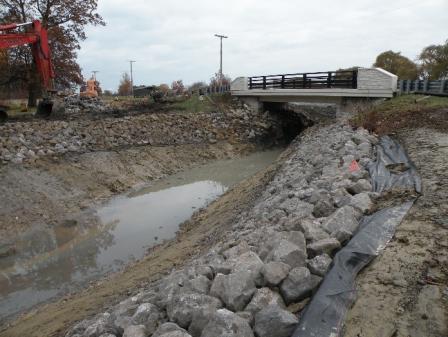 A stop-log weir was replaced with a 50'-wide opening and road bridge to reconnect the Blue Heron Lagoon and Lake Okonoka. Photo Credit: Friends of the Detroit River.The Lake Okonoka Habitat Restoration project is considered to have a significant impact on the removal of the following BUIs:
A stop-log weir was replaced with a 50'-wide opening and road bridge to reconnect the Blue Heron Lagoon and Lake Okonoka. Photo Credit: Friends of the Detroit River.The Lake Okonoka Habitat Restoration project is considered to have a significant impact on the removal of the following BUIs:
- Degradation of Fish and Wildlife Populations
- Loss of Fish and Wildlife Habitat
The Lake Okonoka Habitat Restoration project was a collaborative effort among many project partners, that included a $70,000 local match of funds for design. Construction began in August 2017 and is anticipated to be completed in 2020.
Celeron Island Habitat Restoration Project
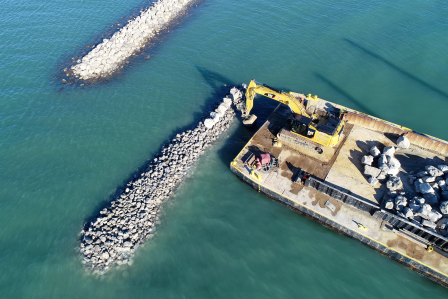 A barge places rocks along a berm constructed to reduce erosion and provide additional spawning habitat within the Detroit RI AOC. Photo Credit: Friends of the Detroit RiverCeleron Island is 68 acres of uninhabited forests and wetlands, located at the south end of the Detroit River and is near the end of the Detroit River AOC boundary. The Celeron Island Habitat Restoration project included the construction of off-shore emergent shoals at the south end of the island. These rock shoals enhanced critical fish spawning habitat as well as stopover habitat for waterfowl. The project is part of a larger effort to address erosion issues on the southern end of the island and restore remnant habitat.
A barge places rocks along a berm constructed to reduce erosion and provide additional spawning habitat within the Detroit RI AOC. Photo Credit: Friends of the Detroit RiverCeleron Island is 68 acres of uninhabited forests and wetlands, located at the south end of the Detroit River and is near the end of the Detroit River AOC boundary. The Celeron Island Habitat Restoration project included the construction of off-shore emergent shoals at the south end of the island. These rock shoals enhanced critical fish spawning habitat as well as stopover habitat for waterfowl. The project is part of a larger effort to address erosion issues on the southern end of the island and restore remnant habitat.
The project started in 2018 and finished at the end of 2019. The project created nearly 4,000 linear feet of shoals, incorporating multiple niche habitats including shallow water habitat, a depression of spawning habitat area, barrier beach, rock piles, basking logs and woody debris bundles. This will benefit multiple species including waterfowl, shorebirds, mudpuppies, turtles, and fish. The emergent shoals will provide protection against future erosion events and allow for regeneration of the island’s outer shoreline emergent vegetation. Completion of the project will advance efforts toward the 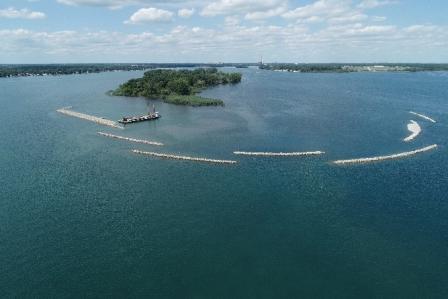 An aerial view showing the construction of emergent shoals off Celeron Island. Photo Credit: Friends of the Detroit Riverremoval of the following BUIs:
An aerial view showing the construction of emergent shoals off Celeron Island. Photo Credit: Friends of the Detroit Riverremoval of the following BUIs:
- Degradation of Fish and Wildlife Populations
- Loss of Fish and Wildlife Habitat
The project partners are listed below:
- Friends of Detroit River.
- Michigan Department of Natural Resources
- National Oceanic and Atmospheric Administration (NOAA)
The Black Lagoon Great Lakes Legacy Act Cleanup
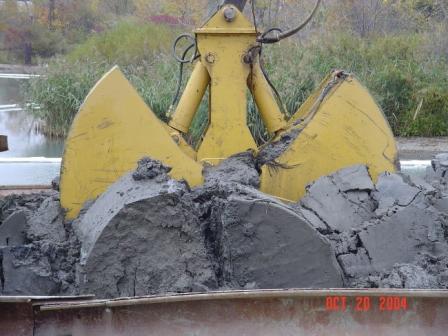 Contaminated sediment is removed from the Detroit River AOC for the Black Lagoon Legacy Cleanup project.
Contaminated sediment is removed from the Detroit River AOC for the Black Lagoon Legacy Cleanup project.
The first Great Lakes Legacy Act project, the Black Lagoon Legacy Cleanup, completed dredging in May 2005. The project removed nearly 116,000 cubic yards of contaminated sediment, greatly reducing PCB, mercury, and oil and grease concentrations.
The city of Trenton also restored a natural shoreline and the site has since been renamed “Ellias Cove” in honor of the family who donated the adjacent land. The $9.3 million project cost was shared between U.S. Environmental Agency (EPA) (65 percent) and Michigan’s Department of Environmental Quality, now Michigan Department of Environment, Great Lakes, and Energy (35 percent).
Completion of the project will advance efforts towards the removal of the following BUIs:
- Degradation of Fish and Wildlife Populations
- Loss of Fish and Wildlife Habitat
- Degradation of Benthos
- Restriction on Dredging Activities
- Fish Tumors or Other Deformities
- Degradation of Aesthetics
- Bird or Animal Deformities or Reproduction Problems
Partners
The following links exit the site Exit

